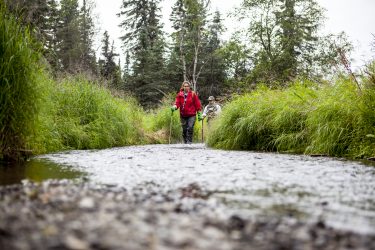
For 20 years, dozens of University of Washington researchers have walked Hansen Creek — home to one of the densest sockeye salmon runs in Alaska’s Bristol Bay region — every day during spawning season, counting live salmon and recording information about the fish that died. After counting a dead fish — an inevitability here, either after spawning or in the paws of a brown bear — researchers throw it on shore to remove the carcass and not double-count it the next day. The data collection is part of a long-term study looking at how bear predation affects sockeye salmon in this region.
When this effort began in the mid-1990s, Tom Quinn, a professor in the UW School of Aquatic and Fishery Sciences, decided that everyone should throw sockeye carcasses to the left side of the stream — facing downstream. They might as well be consistent, he thought, and who knows — maybe someday they could see whether the tossed carcasses had an effect on that side of the stream.
Twenty years later, Quinn and colleagues have found that two decades of carcasses — nearly 600,000 pounds of fish — tossed to the left side of Hansen Creek did have a noticeable effect: White spruce trees on that side of the stream grew faster than their counterparts on the other side. What’s more, nitrogen derived from salmon was found in high concentration in the needles of the spruce trees on the side of the tossed carcasses.
Read more at UW Today »
